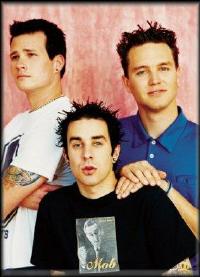The new-school punk trio blink-182 was formed near San Diego, California around Tom Delonge, Mark Hoppus, and original drummer Scott Raynor. Originally known as Blink, the band debuted in 1993 with a self-released album called “Fly Swatter”. After releasing the album “Buddha” in 1994, the trio signed to Grilled Cheese/Cargo records and released “Cheshire Cat” the following year. Since then, they have become pop mainstream with hit songs such as this.
Verse
Listen to the verse with both guitar and bass:
Guitar
This riff will be very easy to play but will allow you to work with some rather odd fingerings on the guitar. The first measure is a basic B chord, played in a less-than-contemporary style. Play the entire measure by placing your 1st finger on the sixth fret on the “A” string, while placing your 2nd finger on the seventh fret on the “low E” string. Play that rather fast to be accurate.
In the second measure, you will be playing an A#m chord. You can do this one of two ways on the sixth fret on the “low E” string. You can either use your 3rd or 4th finger. Your best bet is to use your 1st finger for the fourth fret on the “A” string for the other note.
The third and fourth measures are identical, and you are playing a G#m chord. Do this by once again either using your 3rd or 4th finger on the “low E” string. Use your 1st finger for the second fret on the “A” string though.

Bass
We are back to showing you some bass parts again. This one actually has you playing chords on the bass, which is very common in one guitar bands. Here, you will need to use your 1st and either your 3rd or 4th fingers to play the ninth fret on the “D” string and the eleventh fret on the “G” string. End the measure with an open “D” string.
For the second measure, you will need to just reverse your fingers as they were in the first measure, with your 3rd or 4th finger being on the “D” string, and your 1st finger on the “G” string. End this measure as well with an open “D” string.
The third and fourth measures are also identical here. All you need to do is keep your fingers in the same way that they were for the second measure, and go to the appropriate frets.

Pre-Chorus
Listen to the pre-chorus with both guitar and bass:
For the first measure of the pre-chorus, you will be basically be playing a power chord. The picking here is much more precise though. You will need to use your 1st finger for the second fret on the “A” string. Use your 3rd and 4th fingers for the fourth frets, OR you can just barre the frets with EITHER finger. By barring them, you will open yourself up a little more for the second measure, but there is no real reason that you would have any trouble with the next measure either way.
The second measure simply requires you to barre the fourth frets on the appropriate strings. The third measure is the same thing, but just barre the “low E” string for accuracy. The fourth measure is self explanatory, so try to hit those open “low E” notes in timing as good as possible.

Bass
The bass part is mostly the same concept as the previous bass part in the verse, using only your 1st and either 3rd or 4th fingers in power chord format, so you should have no trouble with this at all.

Chorus
Listen to the chorus with both guitar and bass:
Guitar
The chorus to the riff is easy as well. About the only thing that you will see here that may be weird is the slide and the mutes, but other than that, you will be playing basic power chords here. Use your 1st finger to play the second fret on the “A” string, and your 3rd and/or 4th fingers for the fourth fret on the “D” and “G” strings. Play that and at the end, slide toward the sixth and eighth frets for the next measure.
In this measure, you will be playing the sixth fret on the “A” string, muting the “D” string with your 1st finger angled down, barely resting on the “D” string. Use your 3rd or 4th fingers for the eighth frets on the “G” string.
The third measure will be played just as the first measure was played, but with your fingers on the “low E” string and the “A” string.
For the last measure, simply use your 1st finger and barre the appropriate strings on the second frets. allowing the “low E” string to play open.

Bass
The bass in this part is also easy. You will just be playing the notes with your 1st finger on all the strings and all the frets when applicable.

